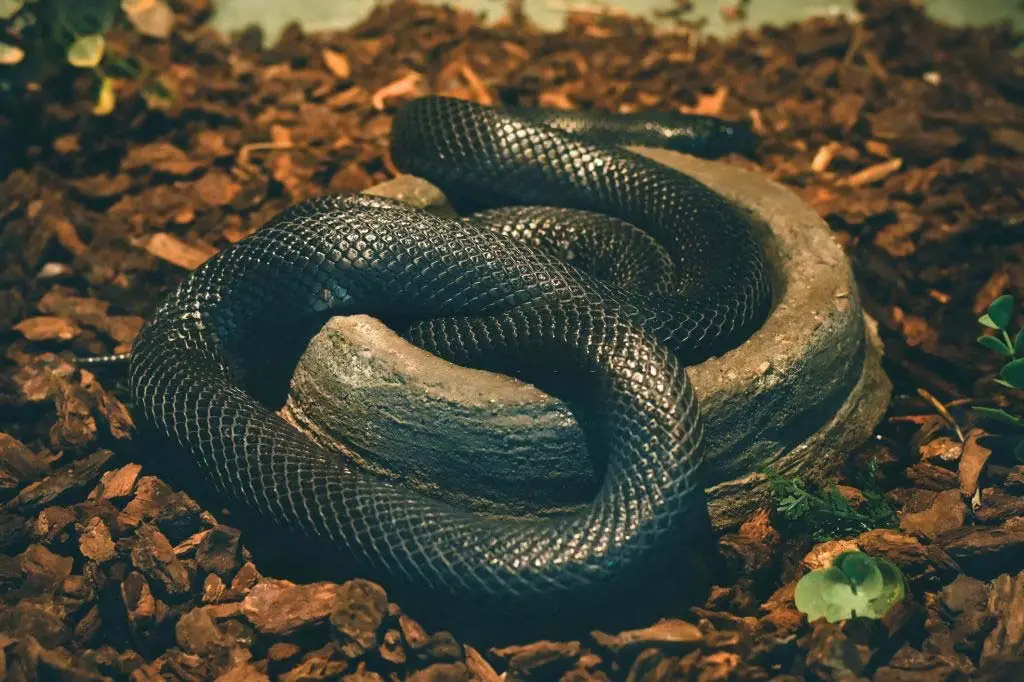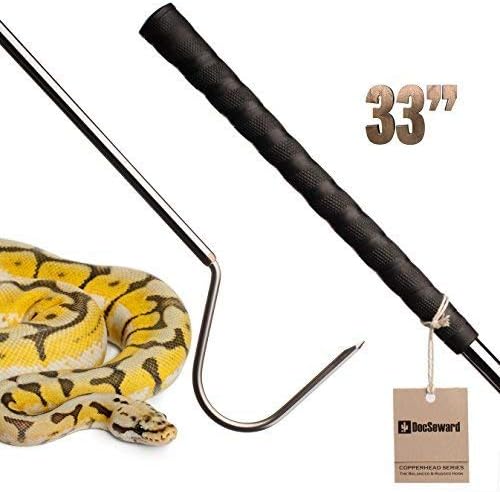Mexican Black Kingsnakes are part of the Kingsnake family and are closely related to the Eastern Kingsnake. Mexican Black Kingsnakes are found throughout Mexico and some parts of Arizona.
They are highly sought after in the pet trade for their beauty and simple husbandry. They are the only Kingsnake to be completely patternless. Their black or dark brown coloring has an iridescent hue in sunlight that shows up in blues or full rainbows like Brazilian Rainbow Boa’s.
These snakes are simple to take care of if you do not mind the odd bite here and there, Mexican Black Kingsnakes are nonvenomous so no need to worry.
| Common Name: | Mexican Black Kingsnake, Black Kingsnake |
| Scientific Name: | Lampropeltis getula nigrita |
| Natural Habitat: | Arid, desert |
| Adult Size: | 3 to 4 feet |
| Lifespan: | 10 to 20 years |
| Diet: | Small mammals, reptiles, other snakes |
| Experience Level: | Beginner |
| Enclosure Size: | 30 gallons |
Reptile Overview
The Mexican Black Kingsnake is a stunning specimen to have on show. We suggest having an enclosure where you can watch your snake move around and live its life.
These snakes are great eaters with a high prey drive. Unfortunately, this means that they cannot be cohabitated with other reptiles, even of their own species as they will cannibalize.
Mexican Black Kingsnakes are easyish to handle due to their size. However, they can move quite quickly so you need to be aware while you are handling them.
These snakes have a fairly complex setup due to their nature. However, when you get the setup right, you will be able to watch your snake bask, move around, climb, and swim.
Appearance
Female Mexican Black Kingsnakes can reach 4 feet in length. They are thicker around their bodies than males. Males typically reach 3 feet and are slimmer than females.
Males and females have the same coloring and patternless bodies. Their coloring can range from jet black to dark brown. Their scales are iridescent in the sun and give off a blueish hue. If you get the light right, you can see the whole rainbow.
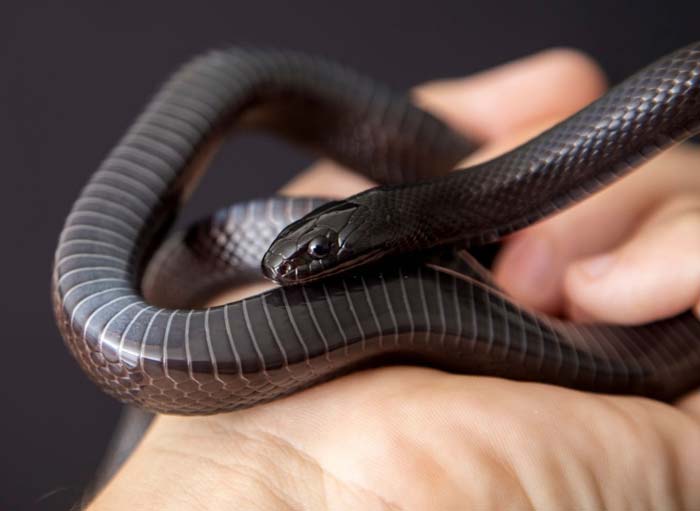
They have smooth, unkeeled scales down their bodies. Their belly scales are either the same shade or can be a lighter shade than the rest of their bodies.
Mexican Black Kingsnakes have a uniform girth throughout their bodies with a much thinner tail. Their heads are only slightly larger than their bodies.
Temperament
Mexican Black Kingsnakes that are wild-caught will have a rough time while being socialized. However, socializing them is possible. Captive-bred is always the better option.
They can be bitey towards their handlers. This is because they have a high prey drive, not because they are aggressive.
While they are calm around humans, they are aggressive towards other snakes and reptiles. They should never be housed with other snakes.
They are known to cannibalize and eat their own kind as well as other species of snake. Breeding time should be the only time two Mexican Black Kings come into contact with each other.
Behavior
These snakes are most often diurnal creatures. This means that they are active during the day. However, some Mexican Black Kingsnakes will display nocturnal behavior, which means they are active at night.
If your Mexican Black Kingsnake displays nocturnal or crepuscular behavior, it might be because they are getting too hot during the day.
When threatened or on the defense, their go-to behavior is to rattle their tail in an imitation of the venomous Rattle Snake. This is to trick predators into thinking they are dangerous and should be left alone.
Lifespan
In the wild Mexican Black Kingsnakes live to around 10 years old.
Captive-bred Mexican Black Kings can live up to 20 years old if they are cared for correctly.
Enclosure
We would recommend an enclosure no smaller than 10 gallons for juveniles.
Exo Terra Terrarium for Hatchlings & Juveniles
At a year old you can upgrade the size of their enclosure. An adult’s enclosure should be at least 36 x 18 inches.
Make sure your enclosure is long enough for there to be an appropriate temperature gradient. This is crucial to the snake’s health.
If your snake is on the larger side, a larger enclosure would be better, approximately 40 gallons. For average snakes, 20 to 30 gallons is sufficient.
Work on 10 gallons per foot of snake. However, bigger is always better for Kingsnakes because they are so active.
All Kingsnakes are master escape artists because of their robust stature. If there is a weakness in your enclosure, they will exploit it and get out. Make sure the lid/door to the enclosure is secured by a clipped latch or lock at all times.
We do not suggest a wooden enclosure. Wood can be tricky to keep clean and can develop mold over time. Mold is toxic to snakes and will cause respiratory infections.
Glass, plexiglass, or plastic aquariums, or terrariums are perfectly fine. Make sure there is a good amount of airflow through the cage; however, this should not disturb the temperature gradient.
Make sure your Mexican Black Kingsnake has sufficient enrichment. They are climbers, burrowers, and swimmers so their enclosures need to provide them with things to do that will stimulate them and keep them happy.
Include perches that are secured to the enclosure and can support your snake’s weight. You can also include rocks or branches that provide elevated lookout spots.
When you use natural items, they must be properly sanitized. Boil the wood/rocks and then place them into the oven at a low temperature to dry them out completely.
You should clean out and sanitize your enclosure once a month.
Substrate
Your Mexican Black Kingsnake’s natural habitat is quite dry. Therefore, do not add mulch or other substrates that will increase humidity.
Never use pine or cedar shavings. These types of woods have oils in them that will irritate the snake’s skin and cause respiratory problems.
Newspaper, paper towels, and aspen shavings are perfect. Adding some dry leaves or hay to the enclosure will provide an interesting environment for your kingsnake to explore.
Galapagos Aspen Digs Shavings Bedding
Before adding enrichment materials to your snake’s enclosure, research them first. Any vegetation that contains oils should never be put in the enclosure.
Avoid small shavings as they can be swallowed by the snake. If you have smaller shavings as substrate, feed your snake in a separate container instead of their enclosure. This is to avoid the snake accidentally eating substrate.
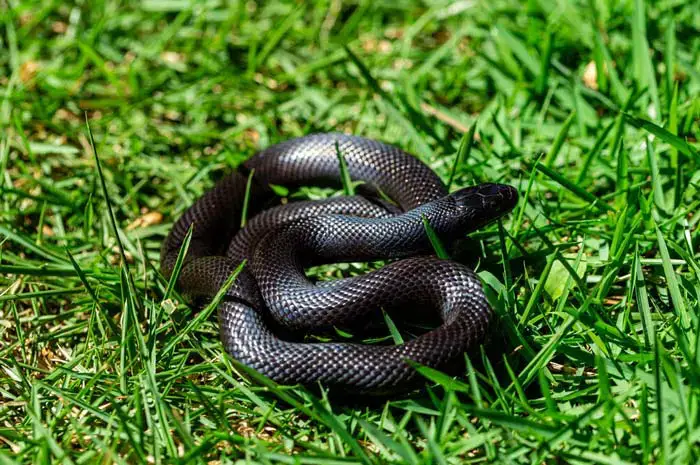
Mexican Black Kingsnakes like to burrow on occasion so make sure that the substrate is deep enough for them to get into/under. This is pretty cool to watch if you have a glass or viewing-enclosure.
Your Mexican Black King’s substrate should be agitated and spot cleaned once a day of droppings. A full clean should happen every 7-14 days where a completely new substrate should be used.
Temperature
Mexican Black Kingsnakes like all reptiles are ectothermic which means that they do not produce their own body heat and need external sources of heat to help them regulate their metabolic processes.
They know when they need to be hot and when they need to be cool. You need to provide them with the temperature gradient so that they can choose their necessary temperature.
We suggest using an under-tank heating pad under a third of the enclosure to help create the warm ambient temperature. Your cool side will be at the opposite end of the enclosure. If the cool side isn’t getting cool enough then adjust the heat settings.
VIVOSUN Reptile Heat Mat with Digital Thermostat
A hideaway should be placed at the 85°F mark. Additional hideaways should be placed in the basking spot and on the cooler end of the enclosure.
Your kingsnake will need a basking spot. You can achieve this by adding a heat lamp or ceramic heat emitter to the top of the enclosure. The bulb or heating element must be in a protective dome or behind a screen top so that the snake cannot touch it and burn itself.
Connect the heat lamp/ceramic heat emitter and the heating pad to a thermostat to control the temperature carefully.
Play around with the heating pad and heat lamp/ceramic heat emitter to find the perfect placement and gradient BEFORE you purchase your snake. Drastically altering the temperature while the snake is in the enclosure can kill it.
If your Kingsnake isn’t using the basking spot at all then it might be too hot. Reduce it 1°F at a time and keep checking for until your snake starts frequenting it.
The same goes for if your snake is always in the basking spot then you may need to up the heating pad slightly. Again, do this 1°F at a time and check for when your snake starts moving throughout the enclosure.
You must have two thermometers in the enclosure at all times to measure the heat in the basking spot and on the cool side of the enclosure.
Zoo Med Labs Digital Hygrometer and Thermometer
You can kill your Mexican Black Kingsnake if the temperature is too high or too low.
| Cool Side: | 75°F |
| Warm Side: | 85°F |
| Basking Area: | 90°F |
Lighting
Full-spectrum lighting is not essential for your Mexican Black Kingsnake. However, UVB lighting has been known to provide additional health benefits like boosted immunity. You will be able to view the iridescent hues in the scales with full-spectrum lighting.
You can get a combined heat and UVB lamp to save on electricity costs or choose the LED terrarium lighting.
Zoo Med Reptisun Led Terrarium Hood
Any lights in the enclosure must be on a timer to provide a 12/12 light/dark photocycle. This will let your snake know when it is day and night. It is best to have the lights on a timer to avoid mistakes.
An inconsistent photocycle will cause your snake stress.
You can keep your Mexican Black Kingsnake’s enclosure in a room that receives natural daylight. But make sure there is no direct sunlight falling on the enclosure as this will cook your snake.
Humidity
Your Mexican Black Kingsnake needs a humidly level of between 40% and 60% The higher end of the range will be necessary for when your Kingsnake is in shed.
There are a number of ways to ensure your snake has optimal humidity. We suggest maintaining a 40% humidity level in the enclosure and provide your snake with a humid hide.
The humid hide needs to be on the warmer side of the enclosure. Take a hide and line it with sphagnum moss. Mist the sphagnum moss regularly to keep it damp. The external warmth will encourage the evaporation of water in the hide and create a humid environment.
Galápagos Terrarium Sphagnum Moss
Use a quality hygrometer to keep an eye on the humidity levels. Play around with the humidity and your process to get it to the optimal range BEFORE your snake comes home.
Additionally, if you do not want a humid hide and decide to maintain an overall level of humidity level of about 50%, keep an eye out for when your Mexican Black Kingsnake is in shed and then mist the enclosure daily to bring the humidity up to 60%.
Always keep a careful eye on the humidity levels. Incorrect humidity levels can result in a stuck shed and infection (too low) or respiratory infections (too high).
Diet
Mexican Black Kingsnakes are good swimmers and will enjoy decent soaking.
Place a water bowl on the cool end of the enclosure:
- Make sure it is large enough for your whole snake to fit in it.
- Make sure that it is deep enough not to spill into the enclosure if the snake goes for a dip. This will increase humidity levels.
- Replace the water with fresh clean water every day. If you see fecal matter replace the water immediately.
- Make sure you clean the water bowl properly to prevent slime build up as this will negatively impact your snake’s health.
- Make sure the water bowl is nonporous to prevent it from interfering with the humidity levels.
Food:
Mexican Black Kingsnakes are good eaters and will eat as often as you provide them with food.
Therefore, it is important to keep them to a weekly or bimonthly feeding routine to avoid obesity.
We suggest feeding your Kingsnake one prey item of appropriate size once a week. Use our prey sizing guide to help you:
Largest point of girth of prey = largest point of girth of the snake.
Mexican Black Kingsnakes eat small mammals and other reptiles in the wild. In captivity, they should be kept on rodents. They switch between mice and rats quite happily.
We always recommend frozen/thawed prey. Frozen/thawed prey items do not carry parasites and cannot harm your snake. Feeding your snake live prey also comes with the additional costs of keeping that live prey in an ethical manner.
When it comes to feeding your snake, place the frozen prey item in a bowl of hot water until the prey is fully thawed. Never feed your snake partially frozen pray as the temperature difference will be fatal.
It rarely happens but if your Kingsnake is a reluctant eater then you can scent the frozen/thawed prey item by rubbing it on another reptile.
You can vary your Kingsnake’s diet by alternating between mice, rats, and chicks when they are large enough.
We always recommend feeding your snake in its enclosure. This will not make it more aggressive.
Handling
Mexican Black Kings can become docile creatures with appropriate handling and will come to recognize you and build a ‘relationship’ with you over time. This is done through gentle and well-timed handling.
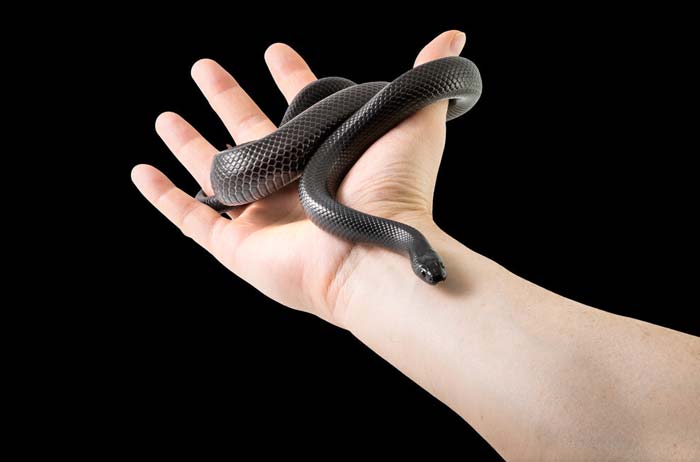
When going to handle your snake you can use two methods:
Scoop
- Gently scoop up the snake from its enclosure with your hands. Do not hold one section of the snake and not support the rest of it as this can harm it and cause a stress response.
- Let the snake get used to your hands before progressing.
- As it is a naturally curious snake that likes to burrow and climb, it will probably check out your pockets or hood.
Hook
If you are nervous about being bitten, you can hook train your snake.
- Using a snake hook, gently nudge the snake to alert it then pick it up using the hook and supporting the body.
- Hook training is not necessary with Kingsnakes; however, if it makes you feel comfortable then there is no harm.
Avoid touching the top of your snake’s head. Most snakes do not like this and are ‘head shy’. They might rear back in freight which can cause the handler to squeeze or drop the snake. This can provoke an attack response or just hurt your snake.
Make sure you do not handle prey items or other reptiles before handling your Mexican Black Kingsnake. If they scent prey they will bite. Sometimes this scent can be their own and they will bite their own bodies!
Avoid handling your snake if it is shedding, Kingsnakes can be a little aggressive around this time as shedding can be uncomfortable.
If you go to handle your snake and it shakes its tail at you, similar to how a Rattle Snake would but minus the rattle, then it is being defensive. If your snake is in this state, rather leave it alone as it does not want to be handled.
Regular careful handling will help you socialize and bond with your snake and provide it with enrichment.
Potential Health Issues
External parasites
Mites are a common issue with snakes. They are small parasites that sit on the snake’s scales and burrow underneath to get at the blood. They are visible to the naked eye as small black or red dots that move.
This is a sign of poor enclosure hygiene. Your enclosure will need full sanitization.
A good indication of a mite infestation is if your Mexican Black King is excessively soaking in its water bowl.
Respiratory issues
These issues can be caused by incorrect humidity levels or incorrect substrate. Make sure that your hygrometer is working and the humidity levels are not exceeding 60%.
Double-check that the substrate you are using does not have shavings from oil-producing trees in it.
Obesity
A fat snake is not a funny snake. Obesity is a real problem among captive-bred snakes. Beginner snake-owners tend to overfeed their snakes.
Being obese puts severe strain on several of the snake’s organs such as its heart and kidneys. This can lead to multi-organ failure.
If your snake is not accepting food and it is not around shedding or breeding time, being very lethargic, over-soaking, or regurgitating its food, take it to the vet. These are all signs that something could be wrong with your pet.
Breeding
Brumation is like a reptile’s version of hibernation. In captivity, you are trying to mimic what would happen in the wild with seasonal temperature and light changes. You will do this by cycling the temperature of the enclosure and extending the dark hours.
Slowly drop the cool side of the enclosure to 65°F. After approximately 3 months you can slowly bring the temperature back to normal.
Ensure that the process of dropping and raising temperatures is slow. If you do it too quickly you can cause your snake severe stress.
Brumation is not essential for the health of your snake. You can keep your snake at normal temperatures all year round. However, it is essential if you are intending to breed your Mexican Black Kingsnakes.
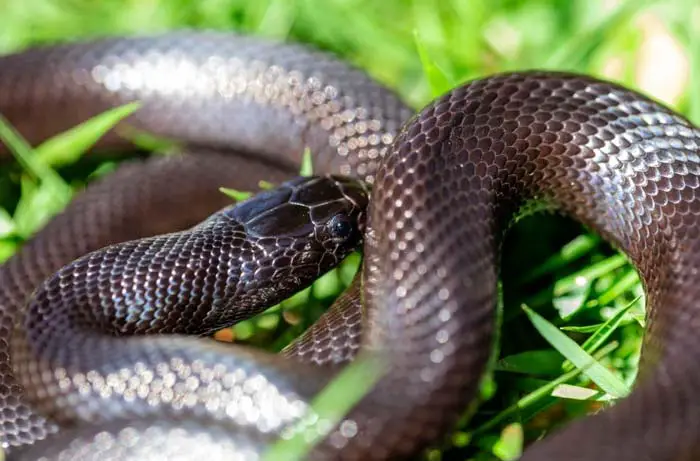
Be sure that your snakes are mature before you start trying to breed them. They reach sexual maturity at three to four years old.
After the female has shed you can introduce the male to her. Leave the shed skin in the enclosure to increase the amount of pheromones the male will smell. Bring the male to the female. You want to keep the female as destressed as possible during this time.
The male will typically ‘pin’ the female with his mouth over her neck while they are coupling. You do not need to freak out, this is normal behavior.
Keep to your normal feeding schedule but be aware that the male might not be receptive to food during this time.
After you are sure that the breeding has been successful and your female is gravid, permanently remove the male from her enclosure. If you leave him in the enclosure, they will become aggressive towards each other.
The female should do a pre-lay shed 4 to 6 weeks before she lays. Once she has done this, put a box lined with moist paper towels, moist vermiculite, or sphagnum moss in the enclosure for her to lay her eggs in.
A clutch can range from 5 to 20 eggs. However, the average is 9 to 12.
Do not let the eggs hatch in her enclosure as she will cannibalize the hatchlings and even possibly the eggs before they hatch. Rather remove the eggs gently as she lays them.
Keep your eggs in a moist container at 82°F.
The baby snakes have an egg tooth that they will use to slit their eggs open. Once they have done this they will sit in their egg and absorb their yolk sac. Do not move them until they have fully absorbed the yolk sac as this has vital nutrients for them.
When they are ready, place them in individual containers because they do cannibalize. Offer them a thawed pinky mouse at a week old. If they do not feed that week, it is okay. Try again every week until they do feed.
Conclusion
Mexican Black Kingsnakes make great pets because they are active and interesting to watch. They are beautiful animals with jet-black scales and bodies that are perfectly sized for easy handling.
Make sure you get your Mexican Black Kingsnake from a reputable breeder to avoid high parasite loads and malnourishment.
We wish you every success on your new journey and ‘herp’ you have a great time with your new best friend!
Related:

